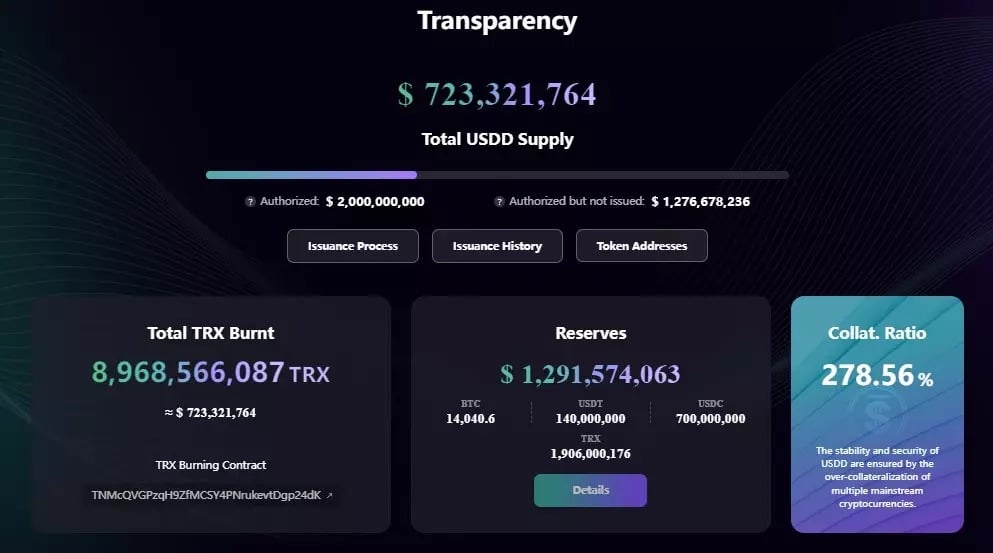On Monday, the Tron DAO added 700 million USDC to the USDD reserve, its algorithmic stablecoin, to avoid following the example of Terra’s defunct UST. While the effort is commendable, there are some things to be wary of. How to distinguish between FUD and legitimate criticism? We take stock of the situation in this article
Tron DAO increases USDD reserve
The USDD, the algorithmic stablecoin of the Tron (TRX) blockchain, recently got a collateralization reserve to secure its peg to the dollar. While the algorithm is already capable of fulfilling this role, these funds are to be used to further secure the edifice, providing a minimum 130% over-collateralisation.
Today, the project announced the arrival of 700 million USDC, which now brings this reserve to nearly 1.3 billion dollars.

USDD reserve status
This liquidity injection is all the more significant as it is roughly equivalent to the capitalisation of the USDD. Thanks to this, the USDD would reach a collateralisation of 278.56% at the time of writing. However, this is not entirely true, although it is the value mentioned.
Indeed, with a capitalisation of 723 million dollars, the rate shown in the illustration takes into account the TRX that were burnt to issue the USDD. As these tokens simply do not exist anymore, a relevant calculation of the collateralisation should only take into account the amount of the reserve. Thus, the actual value of this collateralisation would be 178.56%.
The flaws in this reserve
This pool now relies on four assets to collateralise the USDD:
- The BTC ;
- THE USDT ;
- THE USDC ;
- The TRX.
Although in terms of proportions it is substantial, there are several flaws, the first of which concerns the TRX.
Indeed, if the USDD were to lose its value, it would be necessary to burn some to issue TRX in parallel. The latter would then see its value decrease, due to the inflation caused by the process. Mechanically, the value of the reserve would also fall.
Too large a proportion of TRX in this reserve could then weaken it. While the purpose of this article is not to create FUD, it is important to remember that this is exactly the same phenomenon that caused the collapse of the LUNA token when the UST lost its anchor. Thus, it is necessary to have all the keys in hand to form one’s own opinion.
Another interesting fact concerns the USDT. While the Tron DAO has since made arrangements, one Twitter user noted that until this morning USDTs were actually jUSDTs. This means that the assets were not directly in the reserve’s smart contract, but deposited on the JustLend protocol to generate yield:
2/ That means that the 140M USDT are deposited into JustLend, a lending / borrowing protocol on the $TRX network
They are earning some yield on that, which is understandable
However, we need to consider now that those $140M are subject to smart contract and exploit risk pic.twitter.com/M9zY7bTG43
– Res ®️ (@resdegen) June 12, 2022
TronScan blockchain explorer transactions show that the Tron DAO has now backed off. But even so, the ability to use such freedoms is questionable. And for good reason, while it may be justified by a logic of capital optimisation, it does result in a point of failure in the event of a hack of the JustLend platform.
The impact of falling stock prices
On a more global level, the general fall in prices leads to a decrease in the value of the reserve. This is especially true given that when it announced the reserve last week, the USDD’s collateralization stood at 225%. Or rather 125%, if we only refer to the real value of the assets present in collateral. Whereas this morning, before the arrival of the USDC, those same assets brought the USDD’s collateralization to about 86%.
As the stablecoin’s capitalization is set to increase, this cushion will necessarily need to be replenished to fulfill its role. This recent capital increase is therefore a very appropriate decision, which Tron DAO will have to repeat as the capitalization evolves.
The project’s whitepaper states that the goal is to raise $10 billion to complete the mission. Provided that the USDD teams manage to maintain this over-collateralisation, the consequences of a possible failure of the arbitrage mechanism should be limited, which is what the reserve is for.
On the other hand, it will be important to consider the elements highlighted in this article. After the UST episode, while it is not clear that a near-copy is doomed to failure, it is still necessary to monitor it carefully.
